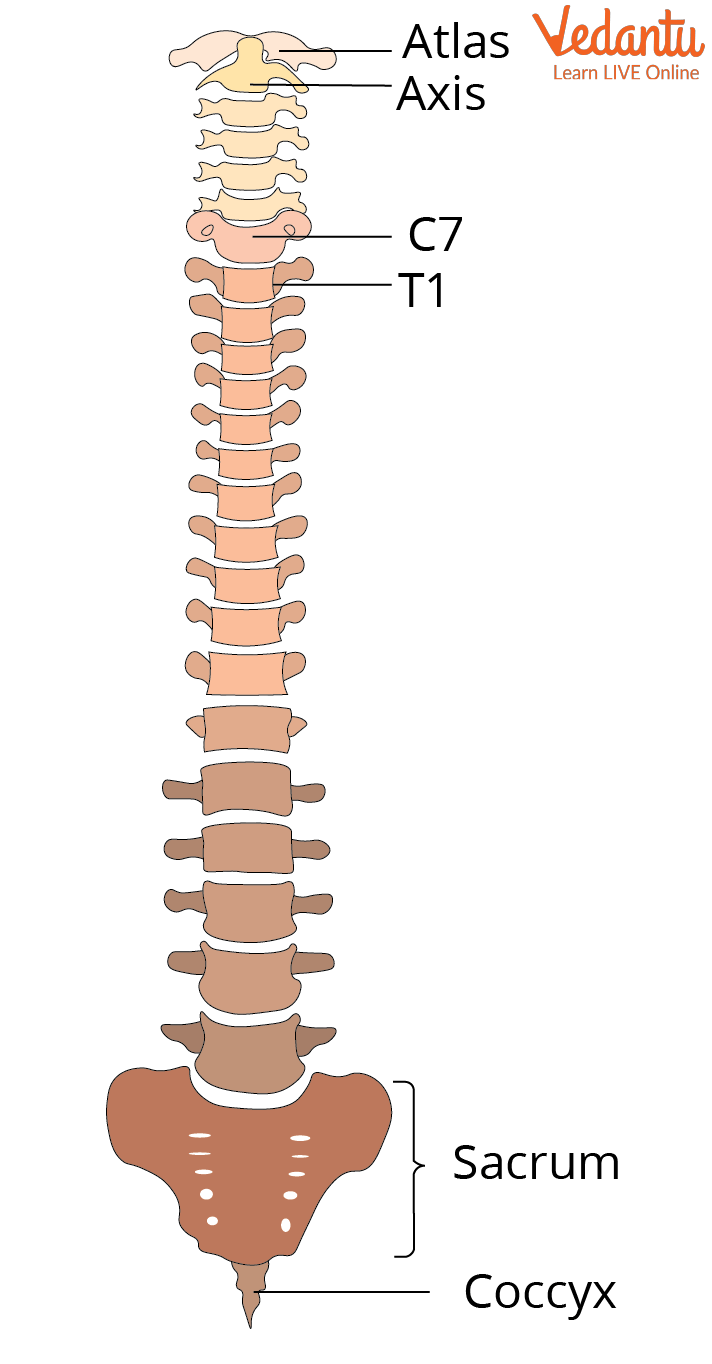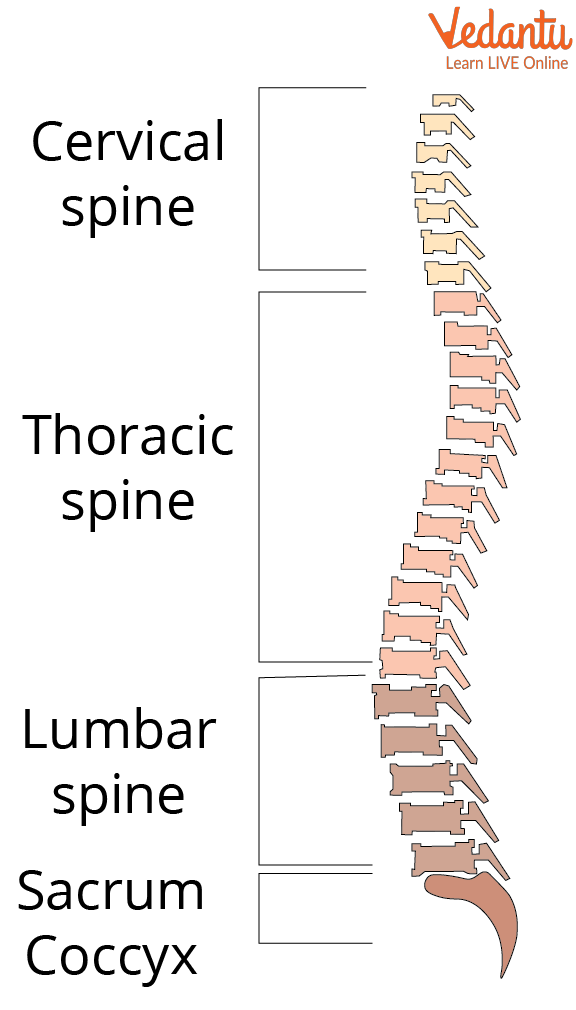




An Introduction to the Spinal Cord
The spinal cord is a lengthy band of tissue that resembles a tube. It links the lower back to the brain. The spinal cord relays nerve messages back and forth from the brain to the body. Your body can move and sense feelings thanks to these nerve messages. Any spinal cord damage can impair motion or function. From the brainstem to the low back, the spinal cord travels through the middle of the spine in a cylinder-shaped arrangement. It is a fragile structure made up of cells and nerve bundles that transmit signals from the brain to the body's other organs. Below we can see a diagram of the spinal cord. In this article, we will learn in detail what a spinal cord is.

Spinal Cord
What is the Spinal Cord?
A column of nerve tissue that runs from the base of the skull down to the centre of the back. It is covered by three thin layers of protective tissue called membranes. The spinal cord and membranes are surrounded by the vertebrae (back bones). The spinal cord and the brain make up the central nervous system (CNS).
Must-Know Information about the Spinal Cord
The primary processing unit of the body is the spinal cord, which receives data from the brain and transmits it to branched nerves that connect to every other part of the body. Additionally, it collects signals from the body and transmits them to the brain, enabling you to respond appropriately to everything from extreme cold to high levels of worry.
The spinal cord serves as the bodily equivalent of a telephone network, transmitting data from the brain to the rest of the body and returning information about the body's health to the brain. This crucial function means that a spinal cord injury can impair even the most fundamental bodily functions, even when the entire body is operating normally.
The Structure of the Spinal Cord
The vertebral column's protective covering encloses the spinal cord's overall structure. The gaps between the vertebral arches are home to the spinal nerves. These distinct sections make up the division of spinal nerves:
Cervical (neck)
Thoracic (chest)
Lumbar (abdominal)
Sacral (pelvic)
Coccygeal (tailbone)

Structure of the Spinal Cord
What Organs and Substances Comprise the Spinal Cord?
The spinal cord is encased in layers of tissue known as meninges, just like the brain. These insulating tissues consist of:
Dura Mater: The outer layer guards against damage to the spinal cord.
Arachnoid Tissue: The layer that lies in the subarachnoid and epidural spaces.
Pia Mater: Certain parts of the spinal cord are inside layers.
Functions of the Spinal Cord
Communication: Different body parts can communicate with the brain by transmitting electrical impulses as they move up and down the spinal cord and through nerves.
Walking: Several muscle units in the legs are continuously contracting and relaxing while a person walks. Since we have been doing it our entire lives, the action of taking step after step could appear incredibly simple to us, but many factors need to be properly coordinated for this to happen.
Reflexes: Reflexes are uncontrollable reactions to stimuli that involve the brain, spinal cord, and peripheral nervous system nerves.
Purpose of the Spinal Cord
The primary function of the spinal cord is to transport nerve information throughout the body. Three vital tasks are accomplished by these nerve signals.
Control Body's Activities and Actions: Movements are controlled by brain signals that are sent to various bodily regions. They also control autonomic processes like heart rate, breathing rate, and bowel and bladder operations.
Send Sensory Data to the Brain: The brain records and processes sensations like pressure or pain with the aid of signals from other areas of the body.
Control Reflexes: An automatic action that our body gives in response to anything is known as a reflex. Some reflexes are managed by the spinal cord, independent of the brain. The spinal cord, for instance, controls the patellar reflex.
Facts about the Spinal Cord
Below are some of the spinal cord facts:
A spinal cord injury (SCI) occurs when the nerves or a portion of the cord near the base of the spine is hurt.
If the brain cannot transfer information past the injury, it may have a significant impact on the body's sensory, motor, and reflex functions.
The extent of the damage increases with the proximity of the injury to the brain. As you may imagine, an SCI can permanently change a person's life.
Summary
The spinal cord extends from your brain down your back. There are billions of nerve cells in this enormous bundle of nerve tissues. Between the brain and the majority of the body, the spinal cord transmits information. The main connection between the brain and the rest of the body is the spinal cord. It has more than 20 million nerve fibres while being only as wide as a little finger. It is connected to the chest, arms, lower body, and legs by 31 pairs of spinal nerves. Spinal cord facts are really interesting. A diagram of the spinal cord is added for better understanding. This was all about the spinal cord. We hope you have learnt something new today!
FAQs on What is the Spinal Cord?
1. What is the spinal cord, explained simply?
Think of the spinal cord as the body's main information highway. It's a long, thin bundle of nerve tissue that extends from the brainstem down your back. Its primary job is to carry messages between your brain and the rest of your body, allowing you to move, feel sensations, and control bodily functions.
2. What are the two primary functions of the spinal cord?
The spinal cord has two main jobs that are crucial for our daily activities:
- Signal Transmission: It relays motor commands from the brain to the body (telling muscles to move) and carries sensory information from the body to the brain (like touch, pain, and temperature).
- Reflex Control: It manages reflex actions, which are quick, automatic responses to stimuli, like pulling your hand away from a hot object. This happens without needing the brain's immediate input, saving critical time.
3. What is the spinal cord made of?
The spinal cord is not made of bone. It is a soft, delicate structure composed mainly of nerve cells (neurons) and supportive cells called glial cells. This entire bundle of nervous tissue is protected by layers of membrane called meninges and is housed inside the bony vertebral column, also known as the backbone.
4. Where is the spinal cord located in the body?
The spinal cord starts at the base of the brain, specifically from an area called the medulla oblongata (part of the brainstem). It then runs down the middle of the back, protected within the central canal of the vertebral column (spine), typically ending in the lower back region.
5. What is the difference between the spinal cord and the spine?
This is a common point of confusion. The spinal cord is the bundle of nerves that carries messages. The spine (or vertebral column) is the stack of bones (vertebrae) that surrounds and protects the delicate spinal cord. So, the spine is the protective bony case, and the spinal cord is the sensitive nerve tissue inside it.
6. How do the brain and spinal cord work together to control our actions?
The brain and spinal cord work as a team. The brain acts as the main command centre, making conscious decisions and initiating voluntary movements. The spinal cord acts as the super-fast messenger, carrying these commands from the brain to the relevant body parts. For sensory information, the spinal cord sends signals from the body up to the brain for processing.
7. Why can an injury to the spinal cord be so serious?
A spinal cord injury is serious because it damages this vital communication link. If the nerves in the cord are damaged, messages from the brain can no longer travel past the point of injury to the muscles below. This disruption in communication can result in a loss of movement and sensation, known as paralysis, affecting the parts of the body controlled by the nerves below the injury site.
8. How does the spinal cord manage a reflex without the brain's help?
The spinal cord can take immediate action through a pathway called the reflex arc. When you touch something dangerous, like a sharp object, sensory nerves send a signal directly to the spinal cord. Within the cord, a special neuron (an interneuron) immediately passes this signal to a motor nerve, which tells your muscles to pull away. This happens in a fraction of a second, even before your brain has fully processed the feeling of pain.









